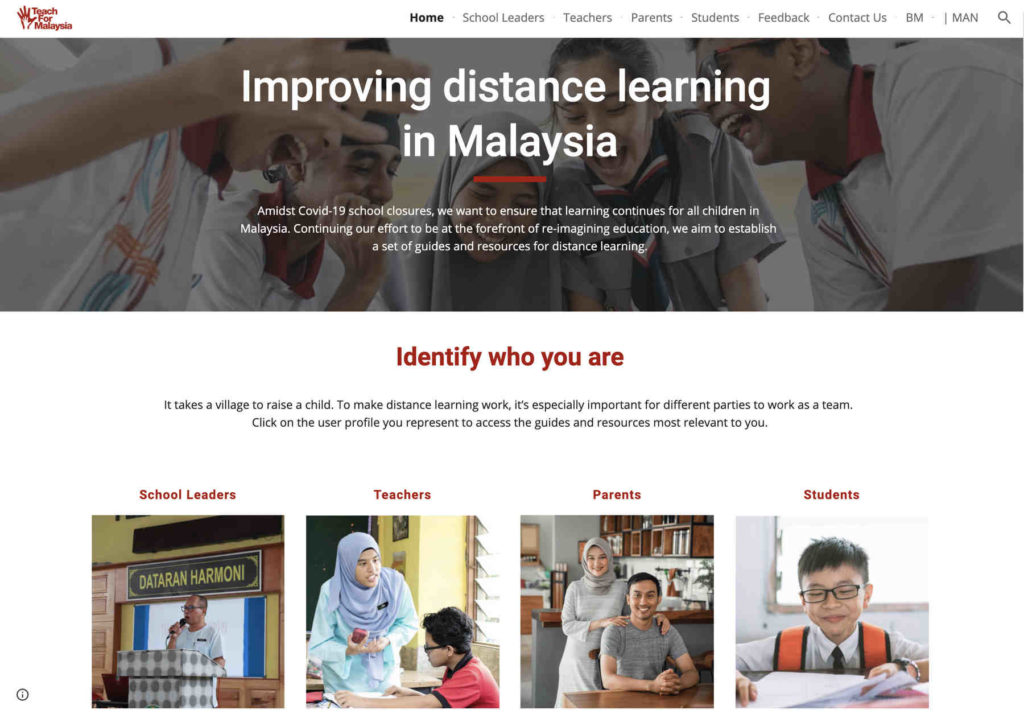When schools in Asia were ordered closed due to the pandemic, many abruptly switched to online and distance learning, relying on education technology so that learning wouldn’t stop.
Malaysia was no exception, enduring three months of strict controls to stem the spread of COVID-19.
Classes gradually reopened over the past few weeks. Malaysia saw schools reopening as of July 22 with a new normal, following health protocols and social distancing rules.
Soon Seng Chan is Chief Executive Officer of Teach For Malaysia, an independent, not-for-profit organization working to end education inequity.
When Soon Seng joined Teach For Malaysia in 2012 he was deeply moved by the challenges faced by students growing up in low-income communities. It’s the lack of opportunities, rather than the lack of ability, that prevented students from reaching their full potential.
On March 18 the Movement Control Order (MCO) caused an immediate shift to home-based learning. Soon Seng saw a risk of increased educational inequity. With e-learning, access to devices and connectivity was still a hurdle for many.
There are advantages and disadvantages of e-learning. Soon Seng shared his thoughts on Malaysia’s switch to online learning at LEARNTech Asia Virtual Conference 2020. The following is adapted from his remarks:
Digital learning platform in place
EdTech tools were prepared by Malaysia prior to the March 18 MCO which closed learning institutions.

Last year the Ministry of Education launched a digital learning platform in which all teachers and students had access to a full suite of Google apps for education. Also available were Microsoft 365 and Apple learning resources.
“The challenge was that most people had not enabled this platform yet or were not used to using this platform,” explained Soon Seng.
“Within a very short period of time, we had to shift to deliver learning through these online methodologies.”
Education technology didn’t reach everyone. Not all households in Malaysia owned a device or had good connectivity to access online learning.
“In a survey done by school leaders, it was estimated that teachers were only regularly in touch with about 50% of their students during this point in time,” said Soon Seng.
The immediate challenge was getting teachers and students proficient with online learning. And having to bridge that gap for the students that don’t have access.
Making it work
Students and teachers were home for the holidays when the school closures were announced. Learners did not have a timetable of what was to happen next.
Without a structure in place, students were being engaged by their teachers in multiple ways.
“I might have a teacher that is trying to WhatsApp me. I might have a teacher that’s trying to call me. I might have a teacher that is trying to get me on a Google Meet lesson,” explained Soon Seng, as he painted a picture of a disorienting student experience.
While some students were experiencing engaging learning from one teacher, another teacher may only be sending messages with reading assignments and homework on WhatsApp.

While there may have been a lack of coordination and guidance from schools at the start, the attitude was to continue teaching despite the pandemic.
“They were just like, we’re gonna continue teaching. Let’s figure that out. And so everyone went and figured it out first and then scrambled back together and tried to put some structure into place.”
Preferred in-person learning
A report that surveyed over 700 students by Project ID, an education social enterprise, revealed their experience of learning in Malaysia during the pandemic.
“Students reported that 80% of them actually preferred offline learning or in-person learning,” said Soon Seng.
Students are accustomed to face to face learning. They didn’t have to struggle with connectivity issues. Some students were not able to hear anything at all during online lessons.
“I’m not asking things like, ‘Oh, can you hear me? Can you see my slides? Can you look at my exercise book?’” said Soon Seng.
An inconsistent learning structure finds a student coming into a Google Meet lesson and not know what was expected of them. Routines were not necessarily set.
In-person interaction makes learning more seamless. And being in school gives consistency, structure, and engaging interactions with the learning experience.
Students said the biggest advantage of online learning, in addition to the flexibility of the schedule, was that they can look up information immediately.
“In a Malaysian classroom — and I’m sure in many classrooms in the world — a teacher asks me a question. I don’t know the answer. I freeze. I feel bad about myself for not learning the answer. But if we’re online, I can access all of that information immediately at my fingertips.”

Teach For Malaysia along with Bain & Company developed TFM Distance Learning, a free online resource site in English, Bahasa Malaysia, and Mandarin Chinese. It has guidelines and resources for school leaders, teachers, parents, and students — to ensure that learning continues during a disruption such as COVID-19.
Offline solutions needed
When it comes to remote learning, solutions are needed for students who don’t have connectivity. Not everything has to happen synchronously. Employing asynchronous solutions is key to addressing issues around medium bandwidth connectivity.
For example, in a WhatsApp lesson, the teacher may post a task at the beginning of the week — a voice message or a picture — and give students time to respond. Then they give feedback to one another through WhatsApp across the duration of the week.
“So you might not do all of your learning together, synchronized in one hour, but you have an asynchronous learning experience,” explained Soon Seng.
Ask your students
It’s important to speak to students. Know what engages them. Nobody has the answer to what’s going to be the perfect online learning solution. We’re all learning it together.
And so if teachers are speaking to students, finding out what they want, what they found useful in their online learning experience, it’s a really important factor in helping to ensure that online learning is effective.
Looking ahead
A key focus in the next five years for many countries is to figure out how to address potential learning gaps that may arise from school interruptions.
Research on the 2005 Pakistan earthquake showed students with 14 weeks of school closure ended with two to three years of a learning gap in comparison to students that weren’t affected by school closures.
Countries and education systems are going to have to severely consider what the issues are around that. When kids get back to school are they starting where they left off? Are they expected to catch up with the curriculum as to where it’s supposed to chronologically be? How are focusing on personalized learning?
Assessments are a huge opportunity. How do we assess in a more authentic way? How are we assessing skills and not just knowledge and regurgitation on an examination paper?
“Our tech capacity, our capacity for teachers’ ability to use tech and students as well — although not complete — will have significantly improved,” explained Soon Seng.
“Openness to using platforms will change over time, so it’s a huge opportunity to think about what tech does in the classroom.”




